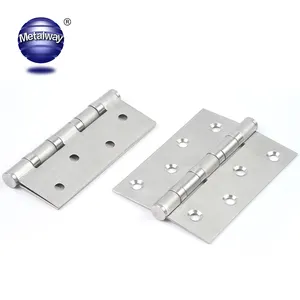


















In the realm of architecture and design, the smallest details are the ones that hold the greatest significance. Metal door hinges certainly fall into this category. Regardless of the modest size, they are a marvel of engineering that plays a pivotal role in people's daily lives, seamlessly facilitating the opening and closing of doors, windows, and other countless movable structures.
Metal hinges are important components as they attach doors to frames, acting as a pivot point for opening and closing. They have several noteworthy benefits compared to their counterparts made from wood or plastic. These hinges are made of sturdy materials like steel, aluminum, and brass, making them incredibly durable. They can withstand frequent use, heavy loads, and harsh weather conditions without succumbing to wear and tear. Their inherent strength adds a layer of security to entryways, as they are harder to tamper with or break. Unlike plastic hinges that usually end up in landfills, metal hinges can be easily recycled or repurposed, therefore contributing to reduced waste and environmental impact. In addition, their longevity means that they rarely need to be replaced, which further contributes to sustainability.
Butt hinges are the classic type when it comes to door hinges. They consist of two identical rectangular wings, one is able to move while the other is fixed in place. The wings are attached to a knuckle, which allows the door to open and close. Steel butt hinges are especially common in the market as the design is well-suited for doors, cabinets, gates, and windows. In ball-bearing hinges, a ball bearing is positioned in between the knuckles. It reduces the friction between the plates, allowing for smooth opening and closing while also reducing hinge wear. Heavy-duty metal hinges are just like the name implies. They are thicker than conventional hinges, usually a quarter-inch more, and are designed for large, heavy doors that experience frequent traffic. Strap hinges are probably the most unique of the lot. They have a short hinge design but have long wings that make them quite fitting for exterior doors. The design provides more support to the door, making them suitable for gates, front doors, and other entryways that get a lot of use.
Metal door hinges come in a wide array of materials, including stainless steel, copper, brass, cast iron, and bronze. The location of the door may play a role in determining the feasible material. For an exterior door, for instance, stainless steel hinges may be suitable due to their sturdiness and ability to resist harsh weather conditions. Door height and thickness determine the number of hinges required for the application. A general rule of thumb is to install one hinge for every 30 inches of the door. The finish is also worth considering, as it can draw attention or enhance a home's cohesive style. For example, installing bright brass hinges in a plain white door can really add to the appeal and make it look new.